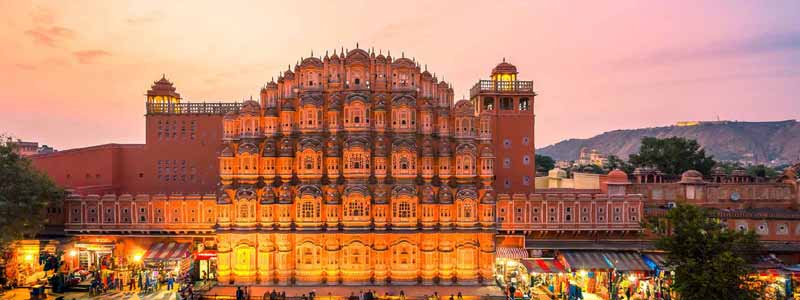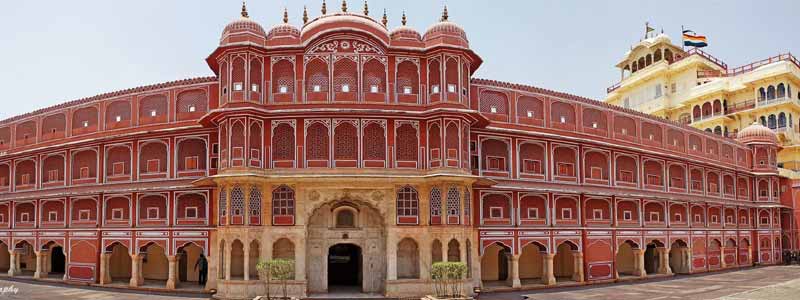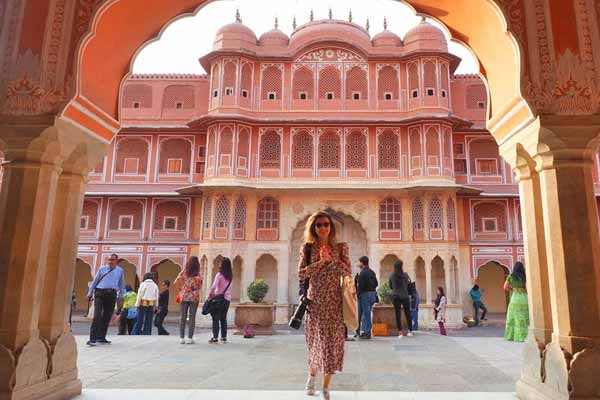Jaipur Travel Guide, the capital of Rajasthan, is the first planned city of India. Also known as the “Pink City”, Jaipur has many coloured gems that signify the ancient history of the place with sight-holding architecture and culture. People visit Jaipur from all around the world for its abundance of beautiful forts and palaces. These forts and palaces take you through a historical journey of cultures and traditions. Jaipur tourism holds many breathtaking experiences with historical palaces and metropolis advantages.
The heritage sites, the food, the arts and crafts, the markets, and the people truly makes this place worth visiting. There’s a wealth of Jaipur tourist attractions waiting to be explored. The traditional jewellery, clothes, artefacts, and handicrafts in Jaipur markets are irresistible. Many hotels in Jaipur let you have traditional experiences of the city and its culture. The cheeriness of the Pink City with decorated roads and statues brings excitement to everyone. With so many festivals and shopping, you get to take home loads of memories.
With affordable hotels and attractions, Jaipur tours are filled with plenty of experiences for you and your family. In this Jaipur Travel Guide, you can find everything you’d want to know about Jaipur tourism.

Jaipur’s history
The city was laid out in 1728 in a simple grid pattern by a young Bengali, Vidyadhar Bhattacharya, architect to Maharaja Sawai Jai Singh II (of the royal lineage that had ruled from Amber, 11km/7 miles to the north, since the early 10th century). Seven blocks of buildings are divided by wide, tree-lined avenues; at the heart of the city is the palace, which covers a further two blocks. These rectangular divisions represent the nine divisions of the universe.
The whole is surrounded by a crenellated wall with seven imposing gates (pols), still in use today. Each of the blocks houses mohallas, districts given over to the practice of various crafts or trades, from bangle-making to fabric dyeing to minakari (enamel work), for which Jaipur Travel Guide is famous.

Why is it called the Pink City?
Jaipur is also called the Pink City. The obvious reason is that the color of most historical places in Jaipur that were made in red sandstone and marble, render a pinkish glow in the sunlight. But there’s a more detailed story behind Jaipur’s moniker.
In 1876, the Prince of Wales and Queen Victoria were to be on a tour of colonial India, which also included a tour and stay in the city. Maharaja Sawai Ram Singh, who was ruling the state at that time, saw this as a great opportunity to strengthen the ties of the royal family with the British aristocracy.
To impress Prince Albert, the maharaja set out to beautify his city, in the colour of hospitality – pink. This included using red sandstone exclusively for newer constructions and repainting older ones with terracotta pink. As expected, the prince was highly impressed and named it the Pink City.
The maharaja’s queen, who also loved the color scheme, convinced the king to make it illegal for the city’s buildings to be painted in any other color from thereon. Thus, in 1877, a law was passed to make all buildings and structures of the city to be done in pink. Surprisingly, the law is still in effect today Jaipur Travel Guide.
Food In Jaipur
Jaipur has also seen a lot of cafes pop up in the recent past. Most of these cafes are excellent and we strongly recommend you visit Tapri on your next trip to Jaipur. It’s a great rooftop cafe to visit around sunset. Grab a chai, take a breath and unwind as you watch the sun slowly come down over this beautiful city in Pink.
Jaipur takes its food extremely seriously. For the capital of a flamboyant state, the food scene in Jaipur is a fusion of the modern with the traditional. The Lassiwala on MI road in Jaipur serves arguably the best lassi in the country. There are a few impostors around, so ensure you go to the legitimate shop (the one with the green and white roof). Masala Chowk near Albert Hall Museum is a food haven for street food lovers. An open air food court with a plethora of food stalls from, Masala Chowk should be on the list of every foodie.
Ensure you get your hands on some dal bati churma, dahi papdi chaat, and some missi roti and dal during your time in Jaipur Travel Guide.
Jaipur Things To Do & See
Jaipur is known for its historical palaces and architecture.Here are some of Jaipur’s must see sights.
- Hawa Mahal Palace
The Hawa Mahal Palace was built in 1799 for the ladies of the Royal household. Hawa Mahal means the ‘Wind Palace’ or the ‘Palace of Winds’. It has 953 small windows, which were built to keep the palace cool during the summer time in older times. The landmark is built with pink and red sandstone and resembles a honeycomb structure and is shaped like a crown. It is a perfect example of a Rajput style architecture. Jaipur Travel Guide To access the Hawa Mahal you need to enter from the side of the City Palace as Hawa Mahal was built as a part of this palace, therefore it doesn’t have its own entrance.
- Jaipur City Palace
Located just behind the Hawa Mahal, the City Palace is a fusion of Rajput and Mughal architecture. It now has the Maharaja Sawai Man Singh II Museum and encompasses several buildings, various courtyards, galleries, restaurants, and the offices of the Museum Trust. The famous structures in the complex are the Chandra Mahal, Mubarak Mahal, Shri Govind Dev Temple and the City Palace Museum.
- Jantar Mantar
Built in the 18th century, the Jantar Mantar is a collection of 19 architectural astronomical instruments. It has been a UNESCO World Heritage Site since 2010. It features the world’s largest stone sundial, and can be found nearby both the City Palace and Hawa Mahal. The instruments in Jantar Mantar allow the observation of astronomical positions with the naked eye, Jaipur Travel Guide.
- Albert Hall Museum
A beautifully built museum, the Albert Hall Museum displays artifacts and information about the history of traditional arts and crafts of Rajasthan. Located near the Jaipur Zoo, at night with all the lights on it looks even more beautiful. People can buy tickets for both morning and evening entry.
- Jal Mahal
Jal Mahal means “Water Palace”. This palace is in the middle of the Man Sagar lake in Jaipur city, built with yellow and red sandstone. Consisting of five floors , but when the lake is full of water then only one floor is visible and the other four floors are underneath the water. The Jal Mahal is embraced in its background by the Rahargarh Hills.The Palace looks beautiful both by day and in night when all lights are on Jaipur Travel Guide.
- Nahargarh Fort
Perched on the edge of the Aravalli Hills, you can catch a glimpse of the city from the Nahargarh Fort, which was opened in 1734. This fort, as well as the Jaipur Amer Fort, and the Jaigarh Fort, were built for defensive purposes. In those times the Kings used to construct their palaces high above ground in order to secure their kingdom from enemies. These days tourists can take their cars to the top but in earlier times people had to climb a lot of steps to reach to the King’s palace.
- Jaighar Fort
The Jaighar Fort is also known as the Victory Fort .Located in Amer which is just next to Jaipur Travel Guide, 12 km, the fort features a cannon named “Jaivana”, which was manufactured in the fort area and was then the world’s largest cannon on wheels. The fort is nearby the Amer Fort and is situated near the Aravalli Hill range.
- Amer Fort
Located in Amer which is 12 km from Jaipur, the Amer Fort is beautifully built and has many artistic style elements. The fort is nearby the Jaighar Fort, overlooking the Maota Lake, which is also the main source of water for the Amer Fort. The fort consists of the Diwan-e-Aam, or “Hall of Public Audience,” the Diwan-e-Khas, or “Hall of Private Audience”, the Sheesh Mahal (mirror palace), or Jai Mandir, and the Sukh Niwas .The fort was the residence of the Rajput Maharajas and their families Jaipur Travel Guide.
- Statue Circle
Statue Circle is a tribute to the founder of Jaipur – Maharaja Sawai Man Singh II. It is a statue that connects four roads and forms a circular passage. It is made up of white marble and illustrates the Maharaja, holding an astrological diagram depicting Maharaja’s love for astrology, Jaipur Travel Guide.
Best Time to Visit Jaipur
As Jaipur is a landlocked city located in the tropical zone, the temperatures are extremes. The best time to visit Jaipur is in the winter season; from October to March. The weather is pleasant, all the tourist places open after the monsoons and our digestive system is also quite efficient then so that we can enjoy the local delicacies.
How Reach Jaipur Pink city
Air : Indian Airlines connect Jaipur with Delhi, Jodhpur, Udaipur, Aurangabad, Bombay, Varanasi, Calcutta, Ahmedabad.
Rail: Jaipur is connected by rail with Delhi, Agra, Ahmedabad, Ajmer, Abu Road (Mount Abu), Udaipur, Bombay and Sawai Madhopur.
Road: Good motorable roads connect Jaipur with Delhi 258 km, Agra 236 km, Bikaner 321 km, Udaipur 405 km, Ajmer 131 km, Jodhpur 316 km, Bharatpur 176 km, Jaisalmer 638 km and Bombay 1202 km. Jaipur Travel Guide
Bus : Regular buses ply from Jaipur to the above places and Alwar, Kota, Sariska, Mathura, Indore, Chittorgarh and Barmer
